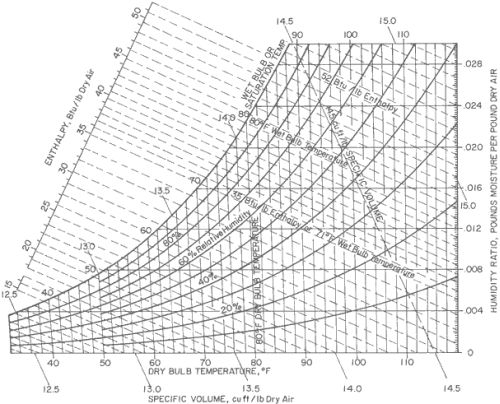First off, Thnx to everyone. And thank you David for taking the time to offer a detailed response. your sealed box analogy makes great sense... to a point.
Simon hit the nail on the head. You see this is the trouble I'm having. I'm looking at this from a standpoint of "how wet is the air"? Perhaps that is where I'm going astray.
Looking at the Psychrometric Chart below... (rough numbers to follow). I see that at 50f and 50% RH you have .004 pounds of moisture per pounds of dry air (PM:PDA). At 110f and 50%RH you have .028 PM:PDA. A substantial increase (x7). So how does my guitar know how much moisture to suck up?
Allow me to clarify and lets put this in David's box. In the two examples above given the same RH, the actual moisture content of the enviroments are substantially different. So, again in the sealed box, what keeps our piece of spruce from being wetter in the .028 PM:PDA box than the other. It seems there would also be a PM:M3S (pounds of moisture per meter cubed of spruce) equation.
Now here I'm guessing (who am I kidding? I'm guessing through this whole thing), but is seems to me our spruce doesn't really care what the temperature is (within limits) so if you put it in a wetter enviroment it is going to take on more moisture. Like any desiccant our spruce will absorb moisture from the surrounding air and if it does not reach its saturation point it will come to equalibrium with the surrounding air. If this is true then that equalibrium point will result in a much higher moisture content for our spruce in a .028 PM:PDA inviroment than it will in a .008 PM:PDA enviroment. Higher moisture content equals swelling in our spruce. Houston we have a problem...
Now please don't take my comments as argumentative. I'm willing to be wrong here. Problem is I'm from Missouri. You need to show me.
Again Thanx to all



